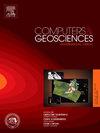3D adaptive finite-element forward modeling for direct current resistivity method using geometric multigrid solver
IF 4.2
2区 地球科学
Q1 COMPUTER SCIENCE, INTERDISCIPLINARY APPLICATIONS
引用次数: 0
Abstract
The direct current (DC) resistivity method is an effective method for detecting subsurface structures with conductive differences. The three-dimensional forward modeling of DC resistivity is essential for data processing and interpretation. In the forward modeling process, solving the large-scale linear system is the most time-consuming step. Traditional algebraic multigrid (AMG) method has been successfully applied to solve the linear system. However, the performance of AMG will deteriorate when dealing with high-order discretization and highly stretched grids. Additionally, in the context of adaptive mesh refinement, the hanging nodes will further complicate the solving process. To address these challenges, we propose a novel geometric multigrid (GMG) method combined with local smoothing for solving the linear system in three-dimensional DC resistivity forward modeling. In this work, we employ high-order basis functions to discretize the problem. To further enhance the accuracy of the numerical solution, the mesh is adaptively refined based on the goal-oriented posterior error estimator. We utilize a V-cycle geometric multigrid on locally refined grids and the hanging node issue is effectively addressed through local smoothing. We also employ the mesh partitioning technique to parallel the solution process. The efficiency, robustness, and parallel performance of our algorithm are verified through various numerical examples.
基于几何多网格求解的直流电阻率法三维自适应有限元正演模拟
直流电阻率法是探测地下导电差异结构的有效方法。直流电阻率的三维正演模拟是数据处理和解释的基础。在正演建模过程中,求解大型线性系统是最耗时的一步。传统的代数多重网格(AMG)方法已成功地应用于求解线性系统。然而,当处理高阶离散化和高度拉伸网格时,AMG的性能会下降。此外,在自适应网格细化的情况下,悬挂节点会使求解过程进一步复杂化。为了解决这些问题,我们提出了一种结合局部平滑的几何多网格(GMG)方法来求解三维直流电阻率正演模拟中的线性系统。在这项工作中,我们采用高阶基函数来离散问题。为了进一步提高数值解的精度,基于目标后验误差估计自适应细化网格。在局部精细化网格上采用v循环几何多重网格,通过局部平滑有效地解决了挂节点问题。我们还采用网格划分技术来并行求解过程。通过数值算例验证了算法的有效性、鲁棒性和并行性。
本文章由计算机程序翻译,如有差异,请以英文原文为准。
求助全文
约1分钟内获得全文
求助全文
来源期刊

Computers & Geosciences
地学-地球科学综合
CiteScore
9.30
自引率
6.80%
发文量
164
审稿时长
3.4 months
期刊介绍:
Computers & Geosciences publishes high impact, original research at the interface between Computer Sciences and Geosciences. Publications should apply modern computer science paradigms, whether computational or informatics-based, to address problems in the geosciences.
 求助内容:
求助内容: 应助结果提醒方式:
应助结果提醒方式:


